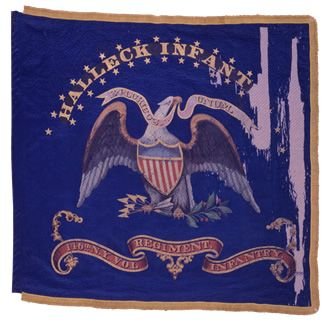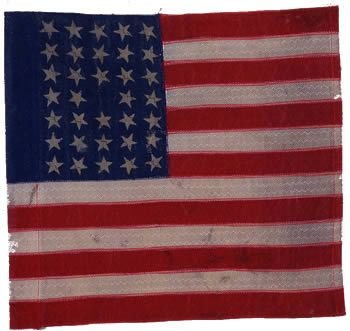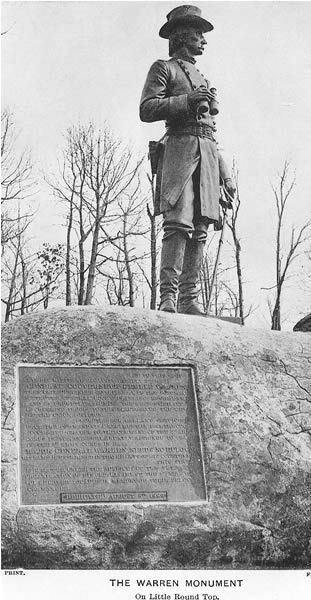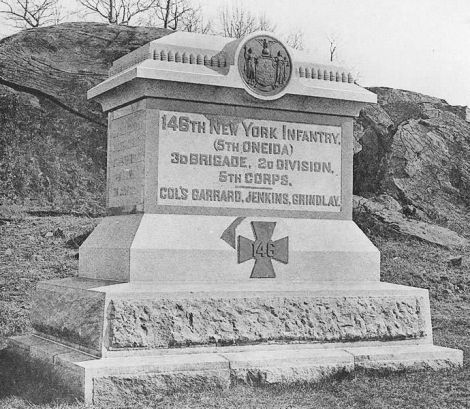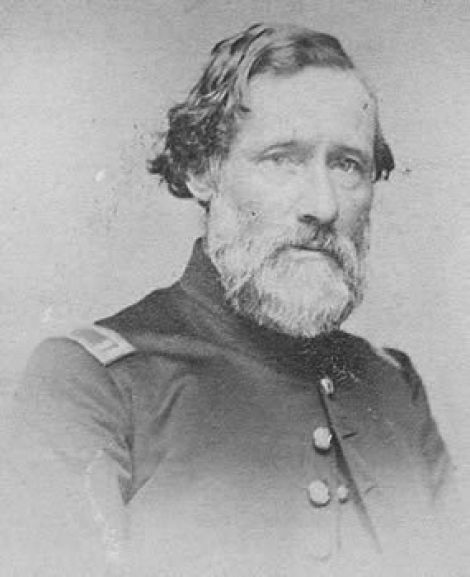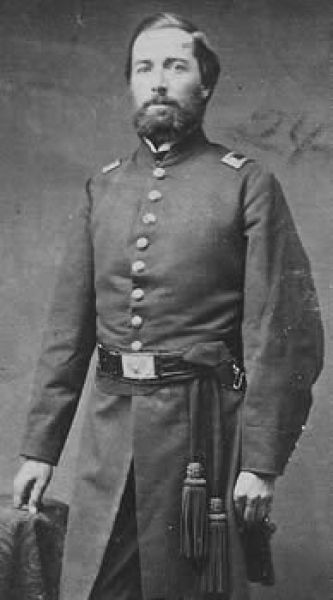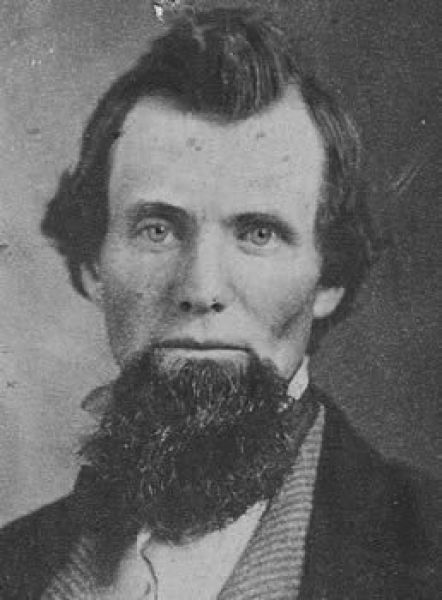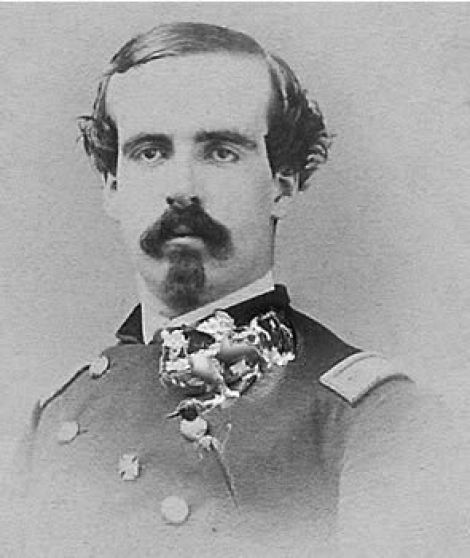Other Resources
This is meant to be a comprehensive list. If, however, you know of a resource that is not listed below, please send an email to ng.ny.nyarng.list.historians@army.mil with the name of the resource and where it is located. This can include photographs, letters, articles and other non-book materials. Also, if you have any materials in your possession that you would like to donate, the museum is always looking for items specific to New York's military heritage. Thank you.
The 146th Regiment : its record from 1862 to 1865 as kept by one of its members. Rome, N.Y. : s.n., 1870-1879. 4 p. ; 28 cm.
Available at Hamilton College.
Avery, John. "Yankee letters from Andersonville prison." Edited by Spencer B. King, Jr. Georgia Historical Quarterly XXXVIII (1954) 394-8.
Barnes, James. Correspondence, 1862-1865.
Chiefly his correspondence to his wife, Catherine Barnes (1862-1865). Other correspondents to Mrs. Barnes are William T. Tull, chaplain at the Washington Street Hospital and Arthur B. Johnson.
52 items.
Bradley, James E. The Civil War letters of James Bradley. [St. Louis, Mo.?] : [publisher not identified], 1992.
Description: 55 pages : portraits, facsimiles ; 28 cm
Abstract: "This is a compilation of the letters of James E. Bradley (1838-87), a soldier in both the Confederate and Union Armies during the Civil War. Also included are a copy of a letter from his daughter, Mary Ann Victoria Bradley and diary entries recorded by his brother and correspondent, Charles E. Bradley."--Introduction. James E. Bradley was born in Northern Ireland and came to the U.S. in 1850 with his parents, who first settled in Schuylkill County, Pennsylvania. In 1858 they moved to a farm in Doniphan County, Kansas. James Bradley left the farm and ended up working in Memphis, Tennessee, where he joined the Confederate Army. He later "became disillusioned by the Southern policy to dissolve the Union", travelled to Virginia and joined the Army of the Potomac using the name McCullough (McCullock), his mother's maiden name. He fought in several battles with Company K of the 146th Regiment, New York State Volunteers. In 1864 he was transferred to Fort Snelling, near St. Paul, Minnesota to serve in "Company Q, known as the Rebel Deserters". Charles E. Bradley, the brother to whom most of the letters were sent was a student at the Academy of Christian Brothers in St. Louis, Missouri.
Held at the Missouri History Museum
Brainard, Mary Genevie Green. Campaigns of the One hundred and forty-sixth regiment New York state volunteers, also known as Halleck's infantry, the Fifth Oneida, and Garrard's tigers. New York: G. P. Putnam's Sons, 1915.
Case, A. P. (A. Pierson) and Patrick A. Schroeder. The Highest praise of gallantry : memorials of David T. Jenkins & James E. Jenkins of the 146th New York Infantry & Oneida Cavalry. Daleville, Va. Schroeder Publications, 2001, 1889.
Case, A Peirson. Notes on the taking and holding of Little Round Top at Gettysburg. Movements of the 146th N.Y. vols. on the field of Gettysburg, July 2, 3, 4 and 5, 1863. [Vernon, 1886].
Coan, Arthur V.; Schroeder, Patrick A. "Uniformly “Zou Zou”." Military Images. 38 :1 (211) Winter 2020. p. 4.
Curran, Henry H. BrakeColl.
(Capt's acct of Gettysburg).
Located at the Military History Institute in Carlisle, PA.
Dumont, Peter L. and Clarinda Dumont. 1858-1880. Papers.
2 boxes (0.50 cubic ft.)
Abstract: These papers consist chiefly of letters Peter L. Dumont sent to his wife Clarinda Dumont in regards to his experiences of military service during the Civil War. Dumont articulately discusses battles and skirmishes, camp life, disease, horrors of war, picket duty, troop movements and the rigors of marching, military strategy, being under fire, and taken prisoner of war. In particular, the letters detail battles at Fredericksburg (December 1862), and Chancellorsville (May 1863), where he was captured and subsequently confined at Libby Prison before he was released on parole. Several of the letters contain pen and ink sketches drawn by Peter Dumont himself that depict his experiences of military service and the war including confinement at Libby Prison. The papers also include photographic portraits of Dumont and family and a Bible that contains more sketches drawn by Dumont on free endpapers.
Located at the New York State Library Manuscripts and Special Collections.
Erdman, Albert. "A Chaplain's experiences." In War talks of Morristown veterans. Morristown: N. J.: 1887.
Faulkner, William. Tuttle Papers.
(Enlisted man's letters, Nov 15, 1862-Dec 1, 1864).
Located at the Military History Institute in Carlisle, PA.
Fisher, John and Fisher, Theodore. Correspondence, 1863-1865.
Handwritten letters. Six of the items were written by John Fisher, while three were written by his brother, Theodore. John and Theodore tell about their experiences in the Army of the Potomac.
9 items.
Located at Brigham Young University.
Flandrau, Thomas M. First reunion of the 146th regiment, N.Y. Vols., August 5, 1886. Rome, N.Y.: Beers & Kessinger,1886. 20 p. 24 cm.
Fowler, Philemon Halstead. Memorials of William Fowler. New York: Anson D. F. Randolph & co., 1875.
Grindlay, James Glass. "The 146th New York at Little Round Top." Battles and leaders of the Civil War III 315.
Grube, Harry T. "146th New York Volunteer Infantry, 1863-1865." Military Collector & Historian. 22 :2 (Summer 1970). 56-57.
Jenkins, David T., & James E. The Highest Praise of Gallantry: Memorials of…of the 146th New York Infantry & Oneida Cavalry. Farmville, VA: Farmville Printing, 2001.
Kennedy, Eric. "Oneida County and Waterville in The Civil War." The Waterville Times. July 8 and August 5, 2009.
Lambie, Gavin Allen. The Gavin Allen Lambie papers,, 1862-1863.
1 box.
Contains the following type of materials: correspondence. Contains information pertaining to the following war: Civil War -- Eastern Theater. Contains information pertaining to the following military unit: 196th New York Infantry Regiment. General description of the collection: The Gavin Allen Lambie papers include officer's letters to friends and sister Jeannette Carter, describes raising of regiment, transfer from Oneida County, defense of Washington, battle of Fredericksburg, the "Mud March" and its outcome, personal health of author; letters from brother John to sister telling of Gavin's death due to illness from the "Mud March."
Located at the Military History Institute in Carlisle, PA.
Livingstone, Charles Brandegee. Charlie's civil war : a private's trial by fire in the 5th New York Volunteers-Duryee Zouaves and 146th New York Volunteer Infantry. Gettysburg, PA: Thomas Publications, c1997.
McAfee, Michael J. "146th New York Volunteer Infantry Regiment, 1863-1865." Military uniforms in America : Long Endure: The Civil War Period, 1852-1867. San Rafael, CA: Presidio Press, 3 of 4 1982. 68-69.
Morgan, John Hunt. The Squire & Chester Tuttle papers, 1861-1864.
Contains the following types of materials: correspondence, diary, casualty list, research papers. Contains information pertaining to the following war and time period: Civil War -- Eastern Theater, -- Gulf. Contains information pertaining to the following military units and organizations: 81st New York Infantry Regiment, Chicago Mercantile Battery, Illinois Light Artillery, 110th New York Infantry Regiment, 189th New York Infantry Regiment, 146th New York Infantry Regiment, 15th New York Engineer Regiment, 14th U.S. Veteran Reserve Regiment. General description of the collection: The Squire and Chester Tuttle papers include 1864 diary and letters of Squire N. Tuttle, 81st New York Infantry; letters of Chester Tuttle, 81st New York Infantry; Phineas H. Castle and Seymour Smith, both 189th New York Infantry; George Perry, Chicago Mercantile Battery; Makendree E. Rowley, 110th New York Infantry; William P. Faulkner, 146th New York Infantry; college research papers on John Hunt Morgan and Battle of Gettysburg.
Located at the Military History Institute in Carlisle, PA.
New York Infantry - 146th Regiment (Vol.) documents, 1862.
Description: 0.015 linear feet (1 folder)
Abstract: One document (ADS) from Major General Kenner Garrard, 1862, and one newspaper account of the regiment's activity in the war.
Held by the University of California, Santa Barbara.
North, Edward. Memorial of Henry Hastings Curran, Lieutenant-Colonel of the One hundred and forty- sixth regiment of the New York state volunteers. Albany: Joel Munsell, 1867.
Pierce, Charles E. et al. Charles E. Pierce cash book and letter, 1853-1879.
Description: .23 linear foot (1 volume, 1 folder)
Abstract: Charles E. Pierce (1842-1907), a farmer from Oneida County, New York, served as a private in Company I of the 146th New York Infantry from 1862 to 1865 during the American Civil War. The Charles E. Pierce cash book, 1853-1879, contains a narrative of his capture at the Battle of the Wilderness in May 1864 and imprisonment at Andersonville, Georgia and Florence, South Carolina; records kept at Camp Parole Hospital, most likely by W. L. Cooper and Pierce as chief ward masters, 1865; Pierce's post-war cash accounts, and his genealogical notes. The volume was previously used by the mercantile firm of Orme, Wilson & Co. of Loudon, Tennessee, and individually by its partner R. T. Wilson, 1853-1863. The volume is accompanied by a letter written by Pierce at Camp Parole to his mother, 1865 May 21; a form letter from a veterans' association dated 188-; his admission ticket to the Soldiers' Reading Room in Philadelphia, and a few clippings relating to the Civil War.
Held at the New York Public Library.
Platt, William H., el al. I now take up my pen ... : the Civil War letters of William H. Platt and Jesse K. Platt, August 1862 - June 1865. [Port Jefferson, New York] Historical Society of Greater Port Jefferson, 2013.
Platt, William H. William H. Platt letters, 1862-1865 ; 1893-1915.
Description: 66 items
Abstract: Letters from William H. Platt of Port Jefferson, N.Y., to members of his family, written while he was serving with the 5th and 146th New York regiments, in northern Virginia, 1862-1865; letters from Platt's brother, Jesse K. Platt, serving with the 127th New York Regiment in Virginia and South Carolina, 1862-1864; and a few miscellaneous business papers, 1893- 1915.
Held by the University of North Carolina, Chapel Hill.
Pohanka, Brian. "A Zouave Sharpshooter." Military Images Magazine (Jul/Aug 1991): pp. 18-19.
Port Jefferson Historical Society. Civil War collection, 1862-1915.
Description: .2 cubic ft
Abstract: Letters, pension records and other military documents of Civil War veterans, including a letter of S.H. Mahaffy and T.A. Mahaffy to "Cousin Nette" describing the second inauguration of Lincoln, 1865. Letters (photocopies) from William H. Platt and his brother Jesse K. Platt, to their father on Long Island, while serving in the 5th, 127th and 146th regiments, New York Volunteers, (Zouave regiments), describe battles, marches, camp life and William's capture by Confederate forces, imprisonment, and eventual release in a prisoner exchange. Also discharge and pension papers, estate papers and miscellaneous documents of William Platt; and Civil War era paper currency.
Held by the Port Jefferson Historical Society.
Pula, James S. and Cherly A. Pula. "With courage and honor" : Oneida County's role in the Civil War. Utica, NY: Ethnic Heritage Studies Center, Utica College, 2010.
Shepard, Norton C. Out of the wilderness : the Civil War memoir of Corporal Norton C. Shepard, 146th New York Volunteer Infantry. Hamilton, N.Y. Edmonston Pub, 1998.
Small, Sam; Small, Wes; Gaede, Frederick C. "Rare Zouave Sergeant's jacket of the famed 146th New York." Military Collector & Historian. 63 :2 Summer, 2011. 101-102.
United States. Army. New York Infantry Regiment, 146th (1862-1865). Rally around the old flag : for the flag and the country : $202 bounty! ... 100 young men wanted for the 5th oneida Reg't!. Utica, N.Y. : Roberts, printer, Morning Herald Establishment, 1862.
1 sheet ([1] pages) : illustrations ; 65 x 48 cm
Held by Hamilton College.
Williams, George Forester. Civil War soldier life : in camp & battle. Brookneal, VA: Patrick A. Schroeder Publications, 1998.
Williams, George Forrester. "Crossing the lines." Blue and Gray I, (1893). 121-6.
Wright, Benjamin Franklin. "From the Wilderness to Richmond." Mollus-Minn. II 7-37.
Wright, William. Manuscript, 1896.
Unbound handwritten manuscript of "Personal recollections of my military service in the 146th regiment, N.Y. Volunteers, during the war of rebellion," by William Wright of Utica, Oneida County, New York, regimental adjutant, dated September 1862-May 1864. Written for his son, Arthur Mower Wright, in 1896. Detailed accounts of his enlisting; army life; personal experiences; engagements at Fredericksburg, Chancellorsville, Gettysburg, et al.; being wounded; recuperation; etc.
1 item (204 p.) ; 6 x 9 in.
Located at the New York Historical Society, New York, NY.
Wolfe, Margett. Letter, 1862.
Description: 1 item
Abstract: Letter from Margett Wolfe, Oneida County, Boonville, NY to soldier Abijah Barnes relating news from home and urging him to take courage. November 26, 1862.
Held by the Fenimore Art Museum.
Unit bibliography from the Army Heritage Center
Items in the museum collection are in bold.
